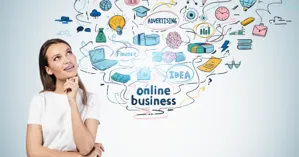
Have you always wanted to own your business? E-commerce allows anyone with a work ethic and a solid business plan to do just that. But many fear the startup costs. Most businesses have small startup costs. Although it will take a lot of hard work, you can start a successful E-commerce business on a budget.
Understanding Online Business

What is an Ecommerce Business?
An ecommerce business is a company that buys and sells goods or services online. It operates through various channels such as an ecommerce store, online marketplace, social media, or a mobile app. These businesses can range from small operations run by a single individual to large global companies with extensive reach. Whether you choose to sell through a single website or multiple sales channels, the goal is to reach customers where they are most active. Ecommerce businesses offer flexibility and scalability, making them an attractive option for modern entrepreneurs.
Benefits of Starting an Online Business
Starting an online business comes with several compelling advantages. One of the most significant benefits is the lower investment requirement compared to traditional brick-and-mortar stores. With minimal capital, you can launch your online business idea from the comfort of your home. Additionally, an online business allows you to reach a global audience, breaking geographical barriers and expanding your market potential. The flexibility to scale your business up or down based on demand makes it an ideal choice for entrepreneurs looking for a dynamic and adaptable business model.
Types of Ecommerce Business Models
There are several types of ecommerce business models to consider, each with its unique approach to buying and selling:
- Business-to-Customer (B2C): Selling products or services directly to individual customers.
- Business-to-Business (B2B): Selling products or services to other businesses.
- Customer-to-Customer (C2C): Facilitating transactions between individual customers.
- Customer-to-Business (C2B): Allowing customers to sell products or services to businesses.
- Dropshipping: Selling products without holding any inventory.
- Wholesaling: Selling products in bulk to other businesses.
- White Labeling: Selling products under a private label.
- Private Labeling: Creating and selling products under a private label.
- Subscription: Offering products or services on a recurring basis.
Understanding these models can help you choose the best approach for your ecommerce business, aligning with your goals and resources.
Research and Planning

Define Your Ecommerce Business Idea
Defining your ecommerce business idea is the cornerstone of starting a successful online business. Begin by identifying what you’re going to sell, who your target audience is, and what sets your business apart from the competition. Consider your skills and expertise, as well as the demand for your products or services.
When defining your ecommerce business idea, ask yourself the following questions:
- What problem do you want to solve for your customers?
- What products or services can you offer to solve that problem?
- Who is your target audience, and what are their needs and preferences?
- What sets your business apart from the competition?
- What are your skills and expertise, and how can you leverage them to create a successful online business?
By answering these questions, you can create a clear and compelling ecommerce business idea that sets you up for success. This foundational step will guide your decisions and strategies as you build and grow your online business.
Choose the Right Business Model

Choosing the wrong business model can make or break your E-commerce budget. There are many options to use when picking a business model. Here are some available. Before choosing a business model, it's crucial to have a well-defined e commerce business idea to guide your decisions.
Dropshipping
With branded dropshipping you sell products under a brand without needing inventory. You partner with suppliers. These suppliers handle:
- product fulfillment
- packaging
- shipping
Because you don’t have to worry about these basics, you’re free to focus on creating a strong brand identity and marketing.
You can offer a great shopping experience that sets you apart from the competition.
You’ll need to settle on your niche or what you’d like to sell. Focus on a speciaty like hair products or fitness. Once you do, choose a dropshipping supplier. There are several criteria for choosing a supplier, they are:
- reputation
- product quality
- shipping
- customer support
- return policy
- branding options
There are many dropshippers you can work with including:
There are minimal costs to building your dropshipping platform, making it an affordable way to set up your ecommerce site.
Sell Digital Products
If you have an expertise in a subject or even a hobby that you’re good at, consider selling a digital product.
Some examples of digital products include:
- eBooks
- printables (like checklists, patterns, spreadsheets etc.)
- online courses (consider using Udemy, Skillshare, YouTube or your blog to sell these)
Utilizing digital marketing strategies can help you reach a wider audience and increase sales of your digital products.
Bloggers can also offer a paid newsletter or membership site.
Affiliate Marketing
Affiliate marketing is when you feature or promote a product and when your viewer purchases it you receive a commission.
A retailer you’re partnering with gives you a unique link that the customer can click to go directly to the product. You don’t have to do anything but promote the product. Some companies that have affiliate programs include:
There are many more affiliate programs, so if you like a product see if they have a program. If they don’t then contact them and explore the possibility of starting one. In addition to affiliate marketing, consider using influencer marketing to further promote your products and reach a larger audience.
Sell Handmade Products
If you’re crafty, turn that into a business. Create your products and sell them. The materials will cost, but if you’re already creating these products anyway, not get paid? There are many places you can sell your creations. Managing online sales effectively is crucial to ensure your handmade products reach a wide audience and generate revenue.
Print on Demand
Print on demand (POD) lets you customize products and sell them under your brand without holding inventory.
This is a particularly good business model if you’re a graphic artist or photographer. Choose the products you would like to sell like:
- t-shirts
- hoodies
- mugs
Then upload an image to the POD. They will print it on the items you have chosen. You could have multiple images on various products.
When someone purchases your products, the POD sends it to be printed and then ships it to the customer, all managed through your ecommerce website. You don’t have to do a thing, and you don’t have to keep inventory. Some PODs include:
There is no upfront capital for POD.
Social Media Marketing for E-commerce

All of these business models can be marketed through social media marketing. For example, you can promote and recommend affiliate products on social media.
With POD, you can also talk up t-shirts, hoodies etc. by using social media.
It’s easier if you have a large following because that’s free.
If you don’t mind paying, many social media platforms let you boost your post for money. You set how much you want to spend per day. Some social media that let you boost are:
- TikTok
You must set up an account and the social network will bill you directly.
Benefits of boosting include:
- maximizing your reach
- reaching your target audience
- enhancing your reach and impact
You don’t have to boost or run ads on social media. If you want to do it organically that’s an inexpensive way of promoting it.
E-commerce Platforms for Running an Ecommerce Website

If you’re selling products, you’ll need an E-commerce platform to host your business website. This might be your only upfront expense.
These platforms come in a wide range of prices. Some will charge hundreds or thousands of dollars per month, but there are some great E-commerce platforms that offer surprisingly low rates.
There’s currently an E-commerce platform price war going on, so it’s a good time to find one that suits your needs.
Here are three affordable E-commerce Platforms.
WooCommerce
WooCommerce is used by more than five million commerce sites worldwide. It’s available as a user-friendly open-source WordPress plugin. It provides:
- product listings & management
- shopping cart & checkout
- order & customer management
- tax & shipping calculations
It helps turn your website into a fully functional online store. Additionally, implementing search engine optimization (SEO) can help your WooCommerce store rank higher in search results and attract more customers.
Go to WordPress plugins and install WooCommerce to use it.
It’s free to download it so it’s cost-efficient. But keep in mind that you’ll need a host to run your website on. WooCommerce doesn’t do that for you. It’s just a plugin. Some hosts you can turn to if you don’t already have one are:
Hosting can be anywhere from three dollars to $21 monthly. All hosts charge based on the size of traffic, so if you hit a home run, your price will go up.
WooCommerce has scalability limitations so when you grow, you might have some performance issues.
Shopify Lite
Most people in E-commerce have heard of Shopify. Unlike WooCommerce it’s not an open source platform. It doesn’t rely on third-party hosting.
Shopify provides the hosting and domain registration. It provides everything you need to run your E-commerce store. But its services come at a price. There are several premium Shopify plans.
- Advanced Shopify - $299 monthly
- Shopify Plan - $79 monthly
- Basic Shopify Plan - $24 monthly
Although it comes with exceptional features, when you’re starting out, you may not have that kind of scratch. Fortunately, there’s another plan.
The Shopify Lite package goes for five dollars per month.
Shopify Lite doesn’t provide the usual capabilities of Shopify, but it’s all about inventory management and integration.
With Shopify Lite, you can start your own ecommerce business by selling your products on third-party platforms like social media or your other pre-existing websites. For example, your main business site.
Shopify Lite integrates your inventory with your social media pages or site. It allows you to start processing credit card payments from either one.
Big Cartel
Big Cartel is inexpensive without complication. If you don’t have the patience to tweak a lot of intricate tools and functionalities this one is for you.
When setting up your Big Cartel store, consider the shipping costs associated with delivering your products to customers.
Setting up is a seamless experience. It’s particularly friendly for artsy items like:
- ceramics
- paintings
- t-shirts
Big Cartel focuses on simplicity and affordability. The themes are customizable, so your E-store won’t look like everyone else.
They have a free version. If you want to add more products and receive advanced features, the cost is $15 per month.
It has inventory syncing capabilities. You can sell your goods both online or in-person. You can also run promos or discounts. This comes with both the paid and free versions.
Conclusion
Setting up an E-commerce store is exciting. But if you’re on a budget you might be nervous about the cost. You don’t have to be. There are many options available that will help you build your business.





